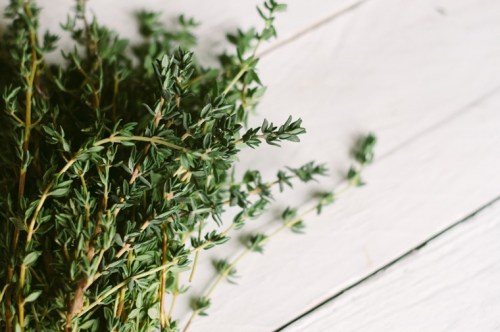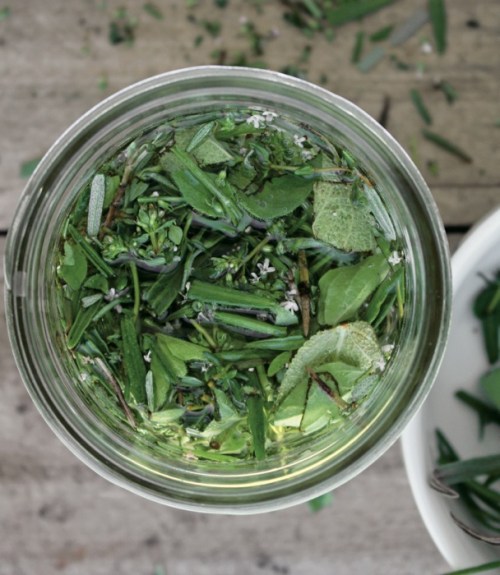Our editors independently select these products. Making a purchase through our links may earn Well+Good a commission
Make your own spring cleaning products with plants from your garden
Lifestyle blogger The Nerdy Farm Wife shares three DIY window and surface cleaning recipes using plants from your garden: rose, thyme, sage, rosemary, and more.

Does just thinking about spring cleaning make you anxious? Dirt, grime, and clutter aside, when you want to clean, you want clean products—and it’s not always so easy to tell what’s toxic and what’s not, even if you’re an expert label reader. (For instance, a multitude of sins can be hidden in “fragrance.”)
One way to know what you’re coating your kitchens, bathrooms, and floors in (and what you’re inhaling while you do it) is to mix up a batch of your own products—something Jan Berry says is easier than you think.
As the writer and photographer behind natural living website The Nerdy Farm Wife, Berry is well-versed in the art and benefits of making products from scratch—using only ingredients you can pronounce and, very often, consume. And her new book, 101 Easy Homemade Products for Your Skin, Health & Home, is packed with natural alternatives to conventional (and often toxin-laced) formulas.
“If you have asthma or breathing issues, a lot of products have scents and toxins that can aggravate them,” she says. “When you go non-toxic you can put less burden on your body.”
Berry is always whipping up new concoctions out on the farm, especially during springtime. But if your garden is less “fields of lilacs” and more of a nook-and-cranny situation—tucked into windowsills, spare corners, or (in a pinch) a fire escape—you can still experiment on your own, she says. The plants, herbs, and flowers used in her formulas can easily be found at home garden centers and other purveyors (she includes a handy guide to her favorite online sources in the book).
Read on to get started with your own all-natural spring clean, with three DIY recipes from The Nerdy Farm Wife.

Rose Window Cleaner
“I absolutely hate washing windows! It’s the worst thing ever for me,” admits Barry, who says chemical-heavy products make her queasy when she uses them. So she concocted this all-natural blend, which cuts grease and boosts shine with white vinegar and corn starch. “Plus, it’s made with beautiful roses and looks pretty, which makes washing windows more bearable. Sometimes I even make a lavender version.”
Makes enough to fill a 2-ounce spray bottle
You’ll need:1 cup fresh pink or red rose petals1 1/2 cups white vinegar2 Tbsp waterPinch of cornstarch
For the rose-infused vinegar:Place the rose petals and vinegar in a pint canning jar. Cover with a plastic or nonmetallic lid. If you don’t have one, place a few layers of plastic wrap or wax paper over the jar before putting the lid on, to keep the vinegar from corroding the metal.
Set the jar aside in a cool, dark place for one to two weeks or until the vinegar turns pink and takes on a light rose scent. If you’d like a stronger smell, add more rose petals and infuse for another week. Strain the finished vinegar into a clean jar. Label, cap and store out of direct sunlight. The color will fade over time, but the vinegar will remain usable for at least one year, or longer.
For the rose window cleaner:Pour 2 tablespoons of rose-infused vinegar into a small spray bottle. Add the water and cornstarch and shake well.
Spritz on windows, mirrors and other glass surfaces, then wipe off with crumpled newspaper or birdseye cotton (the material that diaper flats are made of). Vinegar can damage or cause etching on granite, stone or marble, so avoid using on those types of surfaces.
Tip: It’s easy to scale this recipe up to make larger quantities. Just combine equal parts of water and vinegar, plus a pinch of cornstarch.

Four Thieves Vinegar Spray
Fun fact: This spray was inspired by a legend about four medieval thieves, who somehow managed to rob the graves and homes of those who died of the plague without catching the plague themselves. Their secret? A special vinegar-herb blend, which they used on rags to cover their faces and cleanse their skin post-robbing.
“Based on the story, the thieves made it with an essential oil, but I prefer to use the whole herb,” Barry says. “It’s more satisfying—you can start with the whole plant in your hand and end up with a product.”
While Barry’s formula doesn’t claim to save you from the plague, it is packed with herbs that have disinfecting and microbial properties. Brew up a big batch during cold and flu season and for regular cleaning of high-germ traffic spots like sinks, light switches, and toilet seats.
Makes 1 1/2 cups (375 ml)
You’ll need:1/4 cup each of chopped fresh rosemary, mint, lavender leaves, sage, thyme, and oreganoFew whole cloves (optional)1 1/2 cups vinegarWater, for diluting
Place the herbs in a pint canning jar. Some variations of the recipe contain cloves, for their potent germ-fighting properties. If you like their scent, try adding a few to the jar. Pour the vinegar over the herbs. Add extra vinegar, if needed, to ensure that the herbs are fully covered.
Cover with a nonmetallic lid or place a few layers of wax paper or plastic wrap between the jar and metal lid, to prevent corrosion from the vinegar.
Set the vinegar in a dark place to infuse for one to two weeks. Strain and store in a glass jar. Shelf life is at least one year.
To use, dilute with equal parts of water, and spray on soiled or germy areas, then wipe off with old rags or paper towels. And again, vinegar can damage or cause etching on granite, stone or marble, so avoid using on those surfaces.
Tip: If you don’t have fresh herbs, try using half as much dried herbs instead.

Thyme Counter Cleaner
Bust germs and lift grime with a simple infusion of dried thyme, isopropyl alcohol, liquid castile soap, and water.
“I used to use vinegar and had to tinker to find a formula that’s safe for soapstone and granite counters,” Barry explains. “When I experimented with this one, I loved the green color. Now, it’s one of my favorites.”
Makes 1 cup
You’ll need:1 Tbsp dried thyme3 Tbsp isopropyl (rubbing) alcohol1 cup water2 tsp liquid castile soap
For the thyme-infused alcohol:Place the thyme leaves in a small cup or jar and pour the alcohol over them. Cover, and infuse overnight. The alcohol will turn a pretty shade of green. Strain.
For the counter cleaner:Fill a spray bottle or jar with the water, then gently stir in the castile soap. Pour the infused alcohol into the mixture and stir once more.
Be sure to label your counter cleaner, so no one mistakenly thinks it’s an herbal mixture that can be ingested, and keep it out of the reach of small children.
Shake gently before each use. Spritz over your counters, paying extra attention to especially dirty spots. Use a rag or paper towel to wipe and buff dry.
Tip: If you’re sensitive to the scent of rubbing alcohol, try using clear vodka instead.
And the DIY inspo doesn’t end there: Here’s step-by-step instruction for everyday pantry staples, herbal infusions, and a coffee and coconut body scrub.









